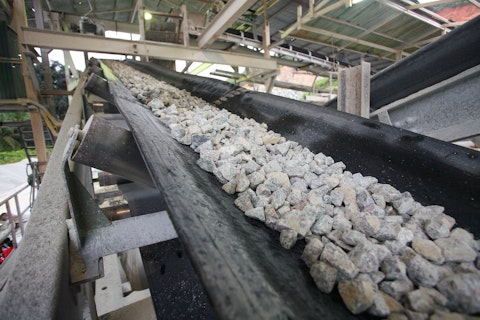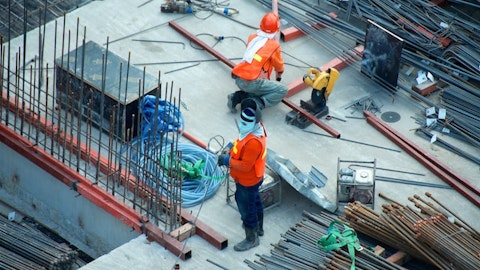Martin Marietta Materials, Inc. (NYSE:MLM) Q2 2023 Earnings Call Transcript July 27, 2023
Martin Marietta Materials, Inc. misses on earnings expectations. Reported EPS is $3.96 EPS, expectations were $4.82.
Operator: Good day and welcome to Martin Marietta’s Second Quarter 2023 Earnings Conference Call. [Operator Instructions] As a reminder, today’s call is being recorded and will be available for replay on the company’s website. I will now turn the call over to your host, Ms. Jennifer Park, Martin Marietta’s Vice President of Investor Relations. Jennifer, you may begin.
Jennifer Park: Thank you. It’s my pleasure to welcome you to our second quarter 2023 earnings call. Joining me today are Ward Nye, Chairman and Chief Executive Officer and Jim Nickolas, Senior Vice President and Chief Financial Officer. Today’s discussion may include forward-looking statements as defined by United States Securities laws in connection with future events, future operating results or financial performance. Like other businesses, Martin Marietta is subject to risks and uncertainties that could cause actual results to differ materially. We undertake no obligation, except as legally required, to publicly update or revise any forward-looking statements, whether resulting from new information, future developments or otherwise.
Please refer to the legal disclaimers contained in today’s earnings release and other public filings, which are available on both our own and the Securities and Exchange Commission’s website. We have made available during this webcast and on the Investors section of our website, supplemental information that summarizes our financial results and trends. As a reminder, all financial and operating results discussed today are for continuing operations. In addition, non-GAAP measures are defined and reconciled to the most directly comparable GAAP measure in the appendix to the supplemental information as well as our filings with the SEC and are also available on our website. Ward Nye will begin today’s earnings call with a discussion of our operating performance.
Jim Nickolas will then review our financial results and capital allocation, after which Ward will conclude with market trends and our outlook for the remainder of 2023. A question-and-answer session will follow. Please limit your Q&A participation to one question. I will now turn the call over to Ward.

wandee007/Shutterstock.com
Ward Nye: Thank you, Jenny. Welcome everyone and thanks for joining this quarterly teleconference. I am pleased to report Martin Marietta’s exceptional performance across nearly every safety, financial and operational measure in the second quarter, which built upon our record first quarter performance. Given the overall challenging macroeconomic environment, including continued monetary policy tightening and the related residential housing slowdown, our strong quarterly performance is a testament to our team’s focus and resiliency of our differentiated business model. In addition to our results and consistent with our aggregates-led product strategy, we also finalized the divestiture of our Stockton, California cement import terminal in the second quarter, further enhancing our company’s margin profile and improving the durability of our business through cycles.
As indicated in today’s earnings release, we revised our 2023 guidance to reflect the company’s results from the first half of the year and our current expectations for the second half. Notably, we raised our 2023 adjusted EBITDA guidance to range from $2 billion to $2.1 billion or a 28% increase at the midpoint as compared with the prior year. The core assumption underpinning the adjusted EBITDA guidance is that accelerated commercial momentum will more than offset lower shipments and higher costs as we endeavor to continue managing the last 2 years of historic inflation. Further, given the typical lag effect between single-family housing starts and aggregates demand, we expect recent aggregate shipments declines will find a bottom in the third quarter of 2023.
Against that backdrop, Martin Marietta achieved strong second quarter results across a number of areas, including consolidated total revenues of $1.82 billion, an 11% increase; consolidated gross profit of $560 million, a 32% increase; adjusted EBITDA of $596 million, a 25% increase; and aggregates gross profit per ton of $6.80, a 28% increase. These stellar results reflect the continued disciplined execution of our strategic plan through economic cycles. Shifting now to our second quarter shipment and pricing results, starting with aggregates. Aggregate shipments declined 5.7% as we experienced the expected lag between last year’s decline in single-family housing starts and our shipments to the residential market. Predictably though, aggregates pricing fundamentals remain attractive, with pricing increasing 18.6% or 17% on a mix-adjusted basis.
The Texas cement market continues to experience robust demand and tight supply amid near sold-out conditions, particularly in the Dallas-Fort Worth Metroplex. Second quarter shipments were a record 1.1 million tons and pricing grew 21.8%. We fully expect that favorable Texas cement commercial dynamics will continue for the foreseeable future and expect solid realization of the $10 per ton price increase effective July 1. Shifting to our targeted downstream businesses, ready-mix concrete shipments decreased 1.7%, while pricing increased a robust 21.9%. Asphalt shipments increased 1.7% and pricing improved 7.9%. Before discussing our outlook for the remainder of 2023, I will turn the call over to Jim to conclude our second quarter discussion with a review of the company’s financial results.
Jim?
Jim Nickolas: Thank you, Ward and good day to everyone. The Building Materials business posted record second quarter revenues of $1.74 billion, an 11.6% increase over last year’s comparable period and a quarterly gross profit record of $536.1 million, a 34.3% increase. Aggregates gross profit improved 20.7% relative to the prior year period resulting in a quarterly record of $370.9 million as strong pricing growth and lower diesel fuel expenses more than offset lower shipments and increased non-energy-related costs. Our Texas cement business also continued its track record of exceptional performance. Revenues increased 21.7% to $197.7 million and gross profit increased 84% to $93.3 million. As previously discussed, our Midlothian, Texas plant is installing a new finish mill that we expect to be finished in the third quarter of 2024.
Upon completion, the new finish mill will provide 450,000 tons of incremental high-margin annual production capacity in today’s sold-out Dallas-Fort Worth marketplace. This project will achieve its first major milestone this month as our new cement titles will begin loading customer trucks. The new silos and load-out system are dramatically improving customer service by reducing load-out cycle times by as much as 45 to 60 minutes per truck during periods of peak shipping. In addition, this project has increased cement storage capacity by over 60%. The process of converting our construction cement customers from Type 1, Type 2 cement to a less carbon-intensive Portland-limestone cement, also known as Type 1L is now complete at both our Midlothian and Hunter, Texas plants.
We expect the Type 1L conversion to provide additional production capacity of 5% this year as compared to 2022 and helped reduce our carbon footprint. Our ready-mix concrete revenues increased 19.7% to $271.4 million and gross profit increased 142.3% to $35.4 million, driven primarily by strong pricing gains in the quarter, more than offsetting higher upstream raw material costs. Our asphalt and paving revenues increased 11.7% to $240.9 million and gross profit increased 37.9% to $36.5 million due to pricing improvement, coupled with lower bitumen costs as compared to the prior period. Magnesia Specialties revenues totaled $80.5 million in the second quarter, in line with the prior year quarter and gross profit increased 13% to $27.7 million.
Notably, gross margin increased 440 basis points from the prior year quarter to 34.4%, driven by pricing growth and moderating energy expenses. As a general matter, energy costs are down from last year’s highs and have now seemingly stabilized. Non-energy costs continue to grow at rates well above historical averages and we expect that to continue throughout the rest of this year. That said, expected midyear price increases should serve to offset the expected cost inflation. During the quarter, we returned $116 million to shareholders through both dividend payments and share repurchases. We repurchased nearly 178,000 shares of common stock at an average price of approximately $422 per share in the second quarter. Since our repurchase authorization announcement in February 2015, we have returned a total of $2.5 billion to shareholders through combination of meaningful and sustainable dividends as well as share repurchases.
Our net debt-to-EBITDA ratio continued its downward trend and ended the quarter at 2.1x, within our targeted range of 2x to 2.5x. This balance sheet strength gives us ample flexibility to continue investing in the business and pursuing accretive acquisition opportunities, while at the same time, extending our long record of returning capital to Martin Marietta’s shareholders. With that, I will turn the call back to Ward.
Please also see 15 Republican Companies with Conservative Values and Most Popular Whiskey Brands in the World.
Ward Nye: Thanks, Jim. With this year’s construction season well underway, we are confident in Martin Marietta’s bright prospects for the remainder of 2023. We continue to be encouraged by a number of factors that support sustainable demand for our products across the infrastructure and heavy non-residential construction sectors. As indicated in our supplemental materials, historic legislation, including the infrastructure investment in Jobs Act or IIJA, Inflation Reduction Act and CHIPS Act are expected to provide funding certainty for large infrastructure, manufacturing and energy projects for years to come. As such, we expect the related product demand for these key end-use segments to be largely insulated from any mild-to-moderate private sector contraction.
We began with infrastructure, which accounted for 36% of our second quarter aggregate shipments. The value of state and local government, highway, bridge and tunnel contract awards, a leading indicator for our future product demand, is again meaningfully higher year-over-year, with growth of 25% to a record $114 billion for the 12-month period ending May 31, 2023. Importantly, in addition to incoming IIJA funding, state legislatures are choosing to commit considerable investment to transportation projects. For example, Texas and North Carolina have directed portions of sales tax collections to infrastructure, while Florida is transferring general funds to augment State Department of Transportation resources. We expect this increase in public sector investment to drive sustained multiyear demand for our products in this important often countercyclical end market.
Moving now to non-residential construction, which represented 35% of our second quarter aggregate shipments. As warehouse construction has moderated from its post-COVID peak, other heavy industrial projects led by onshore manufacturing and energy continued to drive demand in this segment, accounting for the majority of total non-residential shipments. Construction spending for manufacturing in the United States has accelerated to well above record levels as the MACE seasonally adjusted annual rate of spending for 2023 is $194 billion, a 76% increase from the May 2022 value of $110 billion. Since 2021, supported by enhanced federal investment from the Inflation Reduction Act and CHIPS Act, private companies have announced over $500 billion in commitments to invest in critical sectors like semiconductors and electronics, electric vehicle and related batteries and clean energy as those projects are both economic and national security consequence.
Further, the nation’s aim to be the global leader in artificial intelligence and machine learning is expected to drive substantial demand for new data centers for the foreseeable future. As a result, we expect an extended cycle within the aggregates intensive heavy non-residential sector. We also remain optimistic about Martin Marietta’s light non-residential end markets, where we have yet to experience any notable weakness as shipments to in-process projects continue. We are actively monitoring this portion of the segment, but expect any possible future softness to be partially offset by the relative strength of the more aggregates intensive, heavy non-residential project pipeline. Moving to residential. Shipments to this segment accounted for 24% of total aggregate shipments this past quarter.
Given the structural housing deficit in key Martin Marietta markets, we correctly anticipated that the affordability-driven residential slowdown would be short-lived. Accordingly, we are encouraged by recent public homebuilder sentiment and single-family starts data, which are indicative of a near-term bottoming and inflection point. The significant underbuilding over the last decade, coupled with existing homeowners reluctance to abandon their low rate mortgages, is exacerbating the housing deficit, thus available home inventory is being disproportionately driven by new home construction, a notable trend that we expect to continue for the foreseeable future. To conclude, our record-setting second quarter performance provides outstanding momentum and a solid foundation for the balance of the year.
As a result, we are confident in our ability to achieve our raised 2023 financial guidance. We believe our most recent results validate the secular durability of our proven aggregates-led business model and our team’s steadfast commitment to health and safety, commercial and operational excellence, sustainable business practices and the execution of our SOAR 2025 initiatives will support our success. We remain focused on building and maintaining the safest, most resilient and best-performing aggregates-led public company. If the operator will now provide the required instructions, we will turn our attention to addressing your questions.
Q&A Session
Follow Martin Marietta Materials Inc (NYSE:MLM)
Follow Martin Marietta Materials Inc (NYSE:MLM)
Operator: Thank you. [Operator Instructions] The first question comes from Trey Grooms of Stephens. Please go ahead.
Trey Grooms: Hey, good morning, Ward, Jim.
Ward Nye: Good morning, Trey.
Trey Grooms: I guess I want to touch on the cement volume, Ward. It was – seeing it was actually up slightly year-over-year on a tough comp and it’s no secret that Texas weather wasn’t particularly favorable in the quarter. And granted, I think maybe cement can hold up a little bit better in bad weather than maybe aggregates or asphalt, but that’s still impressive. Could you give us a little more color on kind of the drivers there in Texas for cement what you are seeing there with those end markets? And with that, you mentioned you expect favorable traction on the midyear cement increase. Any additional color you could give us around that?
Ward Nye: Happy to, Trey. Thank you for the question. So first, you are right, it was weather in Texas. We had 20 weather-impacted days this quarter as opposed to 16 in the last quarter. I think what that does tell you is the essence of what you asked is right. That is cement because some of it is going to vertical construction as opposed to horizontal construction can actually weather better than aggregates can or asphalt can, because they are both going down literally on the ground in most instances. What I would say relative to the business, number one, it is very durable in Texas. If we go back to our definition of strategic cement, the business we have in Dallas and the business we have in San Antonio fits it perfectly.
If we think about Texas as the market all by itself, North Texas is the single healthiest market in Texas. So if we look at the way Midlothian continues to perform and it’s performing very well. That was the single strongest cement performer that we had. That said, Hunter was a very solid performer as well. So if we are looking at overall volumes at 1.1 million tons, the important thing to remember is markets largely sold out. So in essence, short of that capital project coming through next year, we are basically running at capacity. So having a cement business in Texas with the biggest piece of it in Dallas-Fort Worth, running at capacity is a really good start for a cement business. The second part of your question was relative to the midyear, we have announced a $10 per ton midyear price increase in cement in Texas.
We think we are going to get very good traction on that, so more to come on that as we come toward Q3, but again, a very solid performance by our team. They continue operationally to run that business extraordinarily well. Again, if you are looking at what the pricing has done. Q2 saw pricing up 21.8%, even if you look at mix adjusted, it was still over 21%. But as Jim outlined in his prepared remarks, we continue to see in different parts of the business, degrees of inflation. So part of what we are trying to do with our pricing is stay at least even or try to do some catch-up on that. So Trey, I hope that’s responsive.
Trey Grooms: Yes, absolutely. Thanks for the color, Ward and keep up good work. Thank you.
Ward Nye: Thank you, Trey.
Operator: Thank you. The next question comes from Stanley Elliott of Stifel. Please go ahead.
Stanley Elliott: Hye, good morning, Ward, Jim. Thank you, guys for the question. Ward, I guess we’re getting halfway to the point of the SOAR ‘25 program you outlined a couple of years ago. Where do you think we are strategically from an overall perspective, and I say it in the context that now you have an infrastructure bill, there is other government programs that really weren’t on the table at that time? I’d just like to see how you’re thinking about things.
Ward Nye: Stanley, thanks for that question. So a couple of things. One, if we think about what we outlined is important. We talked about value over volume. If we’re looking at price cost spread, we’re 200 bps ahead of that today. So I think from that perspective, where we thought we would be. If we’re looking at bringing operational excellence to the enterprise, and we’re looking at the best safety metric rates at this time of year we’ve ever seen. If we’re looking at continued throughput and tons produced per working man hour, they continue to go up. But if we also take a look at what we said we would do relative to growing our business, the short answer is we’re ahead of plan on that. If in year 1 in 2021, we bought Tiller and Lehigh West.
We spent year 2 really last year and the year before, doing portfolio shaping and really getting our leverage back down to the areas that we told you that we would. So keep in mind, in a post West Coast world, we are modestly over 3x levered. Today, we’re down to 2.1x. So when we’re looking at our range of debt to EBITDA to 2.5x, we’re actually the lower end of that. And then I think importantly, if we’re looking at the pipeline that we have today to continue growing our business, it’s a very attractive pipeline. And I think what’s important in that, Stanley, is it’s attractive in the areas that we’ve continued to say are most important to our business, and that’s back to the notion of an aggregates-led business. So again, if we’re measuring where we were from the perspective of, we said we thought during that 5-year period, we could double our market cap.
Math tells me we’re like 60% plus there. and we’re about halfway through. So again, tactically, I like where we sit. If we look strategically on how we think it’s coming together. Look, I think at the end of the day, the plan works. So thank you so much for the question.
Stanley Elliott: Great. Thanks, guys. Best of luck.
Ward Nye: You bet.
Operator: Thank you. The next question comes from Kathryn Thompson of Thompson Research. Please go ahead.



